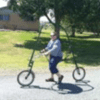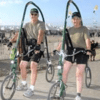At first glance, a GlideCycle™ may appear similar to a bicycle. However, upon closer inspection, there are no pedals and there is no seat pressure in the perineal region (the area where bicycle seats create pressure on sensitive tissues). Thus, operators propel the GlideCycle with a running or gliding motion very different from pedaling a bicycle. One of the key design features of the GlideCycle is its patented pelvic suspension system which allows running and gliding exercise with minimal joint impact.
Bicycling Motion Limitations
When pedaling a bicycle, all of the leg joints, especially the hips, move through a limited range of motion and the hips never fully extend. Thus, cycling leg muscles, especially hip flexors and adductors, are prone to over tightening which may be associated with muscle soreness and eventually, for some, problems with hip joints.
Bicycling Strength Imbalances
Overemphasis on bicycling can lead to significant muscle imbalances. Lower fibers of the gluteal and lower back muscles work in flexed, overstretched positions, and do not develop strength through the full range of motion. This lack of strengthening into an extended, upright position may affect postural control and low back comfort. Cycling is also known to emphasize quadriceps over hamstring muscle development while the core and upper body muscles are minimally engaged except during aggressive mountain biking.
GlideCycle Strength & Motion
Unlike bicycling, GlideCycling promotes full, unencumbered hip motion with each stride. The GlideCycle actually emphasizes muscle development and strengthening in groups that are neglected during cycling such as the Gluteals (especially lower fibers that extend the hip), hamstrings, gastrocnemius, back extensors, core muscles and shoulders. Thus GlideCycling is an optimal fitness experience for many while cross training with the GlideCycle is a great compliment to bicycling.
GlideCycle Strength Benefits
GlideCyclists often notice the comfortable, multidirectional challenges to core and back muscles, which is very similar to the challenge of seated exercise on a large gym ball. In addition, GlideCycling allows a comfortable, upright posture that engages muscles of the upper body and arms more consistently than standard bicycling.
GlideCycle Functional Benefits
Another unique feature of the GlideCycle is that it simulates the functional movement patterns of upright walking and running and utilizes many muscle groups of the body, which in turn, leads to greater functional improvements than bicycling. Such functional improvements are the primary goals of rehabilitation programs and those with mobility limitations.
Balance Requirements
Many individuals who avoid bicycling due to balance and safety issues will find that they are able to safely exercise on the GlideCycle. It simply requires less balance ability than the bicycle as the operator may use two feet, along with the two wheels on the ground at any time. An amputee may use one leg and two wheels which provides a sensation of “three legs”.
GlideCycling for Those Unable to Tolerate Bicycling
From a therapeutic standpoint, there are many individuals with limited exercise options who do very well with GlideCycle training. The GlideCycle allows longer duration and greater intensity exercise with minimal stress to joints and surrounding tissue. GlideCycling is specifically beneficial for individuals who are limited by:
- Reduced tolerance to patellofemoral (knee cap) compressive forces during bicycling.
- Reduced tolerance to tendon and other soft tissue stresses around the knees during bicycling.
- Lack of knee or hip range of motion needed for bicycling due to joint restrictions, pain or obesity.
- Balance impairments, mobility limitations or amputations that do not allow bicycling as an option.
GlideCycling Uphill & Cruising
Bicycling uphill requires a certain intensity to maintain forward motion. For some individuals, this required intensity is too challenging for their level of strength, fitness and overall health. GlideCycling™ uphill does not require such a level of intensity. The GlideCyclist may climb hills as slowly or aggressively as desired by either walking the GlideCycle at the desired pace, or running uphill at a speed that allows a challenging workout. A GlideCyclist may also cruise around comfortably, stop and talk with others or stop to watch a sunset without dismounting which few, if any, could imagine doing on a bicycle.






